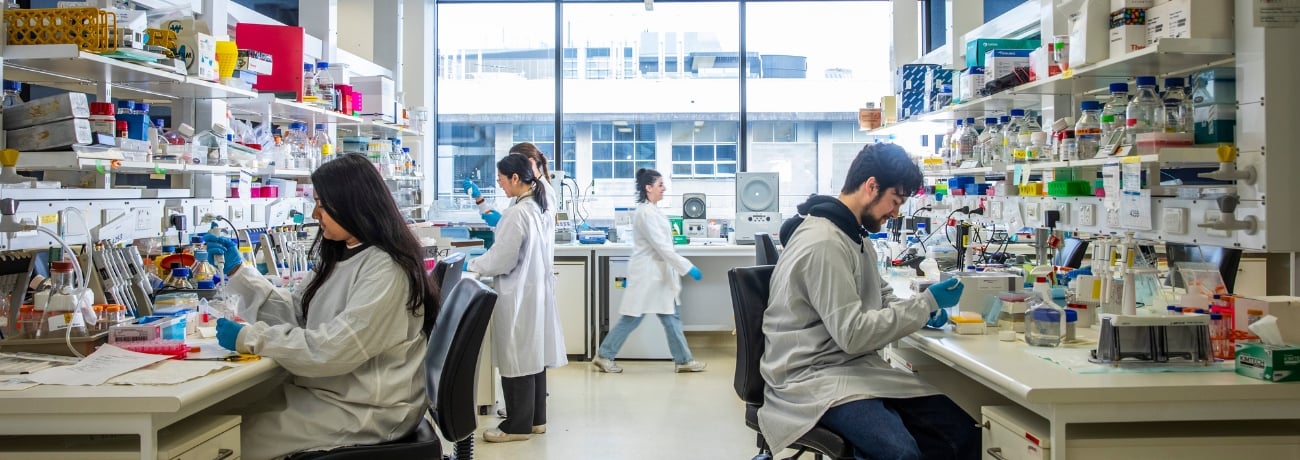Multiple Sclerosis and Myelin Repair Group
Multiple sclerosis (MS) is an inflammatory disease of the central nervous system (CNS), affecting over 2 million people worldwide. Current MS treatments do not prevent ongoing neural damage that leads to progressive disability. Our group is focused on developing new treatments that promote myelin repair to reduce neuronal damage in MS.
Our multidisciplinary team has expertise in myelin biology, genetics and neuroinflammation. We work collaboratively to investigate questions ranging from basic biology, through to translational research and developing novel therapeutic treatments for MS.
Research interests
|
Techniques
|
About our research
We use a variety of techniques and mouse models of MS, as well as directly studying the human disease. We have a number of projects available that are suitable for both honours and PhD students who would like the opportunity to explore the interface of genetics, immunology and neuroscience.
TAM (Tyro3, Axl and Mertk) family
A particular focus of our research is the TAM (Tyro3, Axl and Mertk) family of receptors and their two ligands, Gas6 and Protein S. We have shown that Tyro3 modulates developmental myelination and promotes remyelination, an effect driven partially through Tyro3+ve oligodendrocytes although Tyro3+ve neurons may also be involved in this process.
We have also identified that Mertk, which plays a central role in the clearance of apoptotic cells and myelin debris, is a risk gene for MS. Importantly, we have identified that the TAM ligand Gas6 plays a central role in regulating the response to myelin damage and repair. We are now focused on developing Gas6-based molecules as a treatment for MS.
The role of microglia in MS
In addition to our ongoing interest in TAM receptor signalling in MS, we have a strong interest in understanding the role of microglia in MS. Microglia are a type of immune cell found exclusively in the brain and spinal cord. In addition to their primary function of immune surveillance, microglia also play a vital role in supporting nerve cells and refining the connections between nerve cells.
Studies focusing on microglia in recent decades have begun to identify these cells as essential in outcomes of CNS disease. In certain circumstances, microglia are able to promote brain repair; thus, they are an excellent target for the development of new treatments for MS. This project focuses on manipulating microRNA (miRNA) to enhance their protective function.
Research team
Research team head
Group Head
Team member
Senior Research Officer
PhD students
- Negar Asadian
Research and technical staff
Andrea Aprico
Masters students
- Mohammad Asadian
Selected publications
- Walsh A, Stone S, Aprico A, Kilpatrick T, Ansell B and Binder MD (2016), ‘Mouse microglia express unique miRNA-mRNA networks to facilitate age-specific functions in the developing central nervous system’, doi:10.1101/2022.07.12.499835
- Blades F, Chambers JD, Aumann TD, Nguyen CTO, Wong VHY, Aprico A, Nwoke EC, Bui BV, Grayden DB, Kilpatrick TJ and Binder MD (2022), ‘White matter tract conductivity is resistant to wide variations in paranodal structure and myelin thickness accompanying the loss of Tyro3: an experimental and simulated analysis’, Brain Structure and Function, 227(6):2035–2048, doi: 10.1007/s00429-022-02489-8
- Akkermann R, Aprico A, Perera AA, Bujalka H, Cole AE, Xiao J, Field J, Kilpatrick TJ and Binder MD (2017), ‘The TAM Receptor Tyro3 regulates myelination in the central nervous system’ Glia, 65:581–591, doi:10.1002/glia.23113
- Binder MD, Fox AD, Merlo D, Johnson LJ, Giuffrida L, Calvert SE, Akkermann R, Ma GZ, ANZgene, Perera AA, Gresle MM, Laverick L, Foo G, Fabis-Pedrini MJ, Spelman T, Jordan MA, Baxter AG, Foote S, Butzkueven H, Kilpatrick TJ, Field J (2016), ‘Common and low frequency variants IN MERTK are independently associated with multiple sclerosis susceptibility with discordant association dependent upon HLA-DRB1*15:01 status’, PLOS Genetics, 12(3):e1005853, doi: 1371/journal.pgen.1005853
Contact us
For more information about our group’s research you can contact us by submitting this form.
